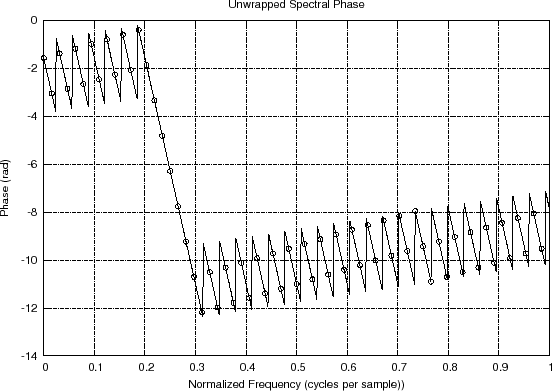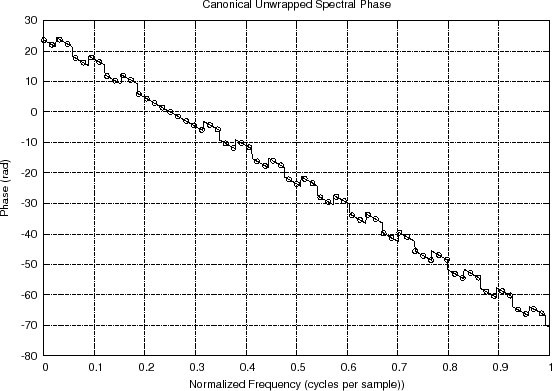Hann-Windowed Complex Sinusoid
In this example, we'll perform spectrum analysis on a complex sinusoid having only a single positive frequency. We'll use the Hann window (also known as the Hanning window) which does not have as much sidelobe suppression as the Blackman window, but its main lobe is narrower. Its sidelobes ``roll off'' very quickly versus frequency. Compare with the Blackman window results to see if you can see these differences.
The Matlab script for synthesizing and plotting the Hann-windowed sinusoid is given below:
% Analysis parameters: M = 31; % Window length N = 64; % FFT length (zero padding factor near 2) % Signal parameters: wxT = 2*pi/4; % Sinusoid frequency (rad/sample) A = 1; % Sinusoid amplitude phix = 0; % Sinusoid phase % Compute the signal x: n = [0:N-1]; % time indices for sinusoid and FFT x = A * exp(j*wxT*n+phix); % complex sine [1,j,-1,-j...] % Compute Hann window: nm = [0:M-1]; % time indices for window computation % Hann window = "raised cosine", normalization (1/M) % chosen to give spectral peak magnitude at 1/2: w = (1/M) * (cos((pi/M)*(nm-(M-1)/2))).^2; wzp = [w,zeros(1,N-M)]; % zero-pad out to the length of x xw = x .* wzp; % apply the window w to signal x figure(1); subplot(1,1,1); % Display real part of windowed signal and Hann window plot(n,wzp,'-k'); hold on; plot(n,real(xw),'*k'); hold off; title(['Hann Window and Windowed, Zero-Padded, ',... 'Sinusoid (Real Part)']); xlabel('Time (samples)'); ylabel('Amplitude');The resulting plot of the Hann window and its use on sinusoidal data are shown in Fig.8.7.
![\includegraphics[width=\twidth]{eps/hanning}](http://www.dsprelated.com/josimages_new/mdft/img1518.png) |
Hann Window Spectrum Analysis Results
Finally, the Matlab for computing the DFT of the Hann-windowed complex sinusoid and plotting the results is listed below. To help see the full spectrum, we also compute a heavily interpolated spectrum (via zero padding as before) which we'll draw using solid lines.
% Compute the spectrum and its alternative forms: Xw = fft(xw); % FFT of windowed data fn = [0:1.0/N:1-1.0/N]; % Normalized frequency axis spec = 20*log10(abs(Xw)); % Spectral magnitude in dB % Since the nulls can go to minus infinity, clip at -100 dB: spec = max(spec,-100*ones(1,length(spec))); phs = angle(Xw); % Spectral phase in radians phsu = unwrap(phs); % Unwrapped spectral phase % Compute heavily interpolated versions for comparison: Nzp = 16; % Zero-padding factor Nfft = N*Nzp; % Increased FFT size xwi = [xw,zeros(1,Nfft-N)]; % New zero-padded FFT buffer Xwi = fft(xwi); % Compute interpolated spectrum fni = [0:1.0/Nfft:1.0-1.0/Nfft]; % Normalized freq axis speci = 20*log10(abs(Xwi)); % Interpolated spec mag (dB) speci = max(speci,-100*ones(1,length(speci))); % clip phsi = angle(Xwi); % Interpolated phase phsiu = unwrap(phsi); % Unwrapped interpolated phase figure(1); subplot(2,1,1); plot(fn,abs(Xw),'*k'); hold on; plot(fni,abs(Xwi),'-k'); hold off; title('Spectral Magnitude'); xlabel('Normalized Frequency (cycles per sample))'); ylabel('Amplitude (linear)'); subplot(2,1,2); % Same thing on a dB scale plot(fn,spec,'*k'); hold on; plot(fni,speci,'-k'); hold off; title('Spectral Magnitude (dB)'); xlabel('Normalized Frequency (cycles per sample))'); ylabel('Magnitude (dB)'); cmd = ['print -deps ', 'specmag.eps']; disp(cmd); eval(cmd); disp 'pausing for RETURN (check the plot). . .'; pause figure(1); subplot(2,1,1); plot(fn,phs,'*k'); hold on; plot(fni,phsi,'-k'); hold off; title('Spectral Phase'); xlabel('Normalized Frequency (cycles per sample))'); ylabel('Phase (rad)'); grid; subplot(2,1,2); plot(fn,phsu,'*k'); hold on; plot(fni,phsiu,'-k'); hold off; title('Unwrapped Spectral Phase'); xlabel('Normalized Frequency (cycles per sample))'); ylabel('Phase (rad)'); grid; cmd = ['print -deps ', 'specphs.eps']; disp(cmd); eval(cmd);Figure 8.8 shows the spectral magnitude and Fig.8.9 the spectral phase.
There are no negative-frequency components in Fig.8.8 because
we are analyzing a complex sinusoid
![]() ,
which has frequency
,
which has frequency ![]() only, with no component at
only, with no component at ![]() .
.
Notice how difficult it would be to correctly interpret the shape of the ``sidelobes'' without zero padding. The asterisks correspond to a zero-padding factor of 2, already twice as much as needed to preserve all spectral information faithfully, but not enough to clearly outline the sidelobes in a spectral magnitude plot.
Spectral Phase
As for the phase of the spectrum, what do we expect? We have chosen
the sinusoid phase offset to be zero. The window is causal and
symmetric about its middle. Therefore, we expect a linear phase term
with slope
![]() samples (as discussed in connection with the
shift theorem in §7.4.4).
Also, the window transform has sidelobes which cause a phase of
samples (as discussed in connection with the
shift theorem in §7.4.4).
Also, the window transform has sidelobes which cause a phase of ![]() radians to switch in and out. Thus, we expect to see samples of a
straight line (with slope
radians to switch in and out. Thus, we expect to see samples of a
straight line (with slope ![]() samples) across the main lobe of the
window transform, together with a switching offset by
samples) across the main lobe of the
window transform, together with a switching offset by ![]() in every
other sidelobe away from the main lobe, starting with the immediately
adjacent sidelobes.
in every
other sidelobe away from the main lobe, starting with the immediately
adjacent sidelobes.
In Fig.8.9(a), we can see the negatively sloped line
across the main lobe of the window transform, but the sidelobes are
hard to follow. Even the unwrapped phase in Fig.8.9(b)
is not as clear as it could be. This is because a phase jump of ![]() radians and
radians and ![]() radians are equally valid, as is any odd multiple
of
radians are equally valid, as is any odd multiple
of ![]() radians. In the case of the unwrapped phase, all phase jumps
are by
radians. In the case of the unwrapped phase, all phase jumps
are by ![]() starting near frequency
starting near frequency ![]() .
Figure 8.9(c) shows what could be
considered the ``canonical'' unwrapped phase for this example: We see
a linear phase segment across the main lobe as before, and outside the
main lobe, we have a continuation of that linear phase across all of
the positive sidelobes, and only a
.
Figure 8.9(c) shows what could be
considered the ``canonical'' unwrapped phase for this example: We see
a linear phase segment across the main lobe as before, and outside the
main lobe, we have a continuation of that linear phase across all of
the positive sidelobes, and only a ![]() -radian deviation from that
linear phase across the negative sidelobes. In other words, we see a
straight linear phase at the desired slope interrupted by temporary
jumps of
-radian deviation from that
linear phase across the negative sidelobes. In other words, we see a
straight linear phase at the desired slope interrupted by temporary
jumps of ![]() radians. To obtain unwrapped phase of this type, the
unwrap function needs to alternate the sign of successive
phase-jumps by
radians. To obtain unwrapped phase of this type, the
unwrap function needs to alternate the sign of successive
phase-jumps by ![]() radians; this could be implemented, for example,
by detecting jumps-by-
radians; this could be implemented, for example,
by detecting jumps-by-![]() to within some numerical tolerance and
using a bit of state to enforce alternation of
to within some numerical tolerance and
using a bit of state to enforce alternation of ![]() with
with ![]() .
.
To convert the expected phase slope from ![]() ``radians per
(rad/sec)'' to ``radians per cycle-per-sample,'' we need to multiply
by ``radians per cycle,'' or
``radians per
(rad/sec)'' to ``radians per cycle-per-sample,'' we need to multiply
by ``radians per cycle,'' or ![]() . Thus, in
Fig.8.9(c), we expect a slope of
. Thus, in
Fig.8.9(c), we expect a slope of ![]() radians
per unit normalized frequency, or
radians
per unit normalized frequency, or ![]() radians per
radians per ![]() cycles-per-sample, and this looks about right, judging from the plot.
cycles-per-sample, and this looks about right, judging from the plot.

Raw spectral phase and its interpolation 
Unwrapped spectral phase and its interpolation 
Canonically unwrapped spectral phase and its interpolation |
Next Section:
Spectrogram of Speech
Previous Section:
Use of a Blackman Window








![\includegraphics[width=\twidth]{eps/specmag}](http://www.dsprelated.com/josimages_new/mdft/img1519.png)











